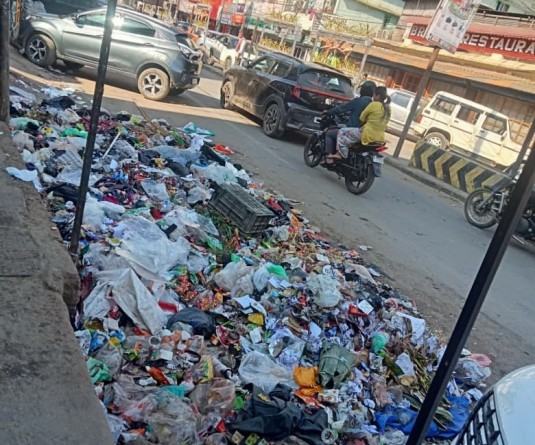
Morung Express News
Dimapur | March 20
The Comptroller and Auditor General (CAG) of India’s audit report on Nagaland’s state finances for 2022-23 revealed a sharp rise in fiscal deficit, a decline in grants from the central government, and increasing public debt. The report, which was tabled in the Nagaland Legislative Assembly recently and has been uploaded on the CAG website, provided an overview of the state’s revenue and expenditure, financial management, and budgetary trends.
The CAG report painted a mixed picture of Nagaland’s financial health. While the state witnessed economic growth, the increasing fiscal deficit, rising debt, and shrinking grants from the central government pose challenges for long-term sustainability. The heavy reliance on revenue expenditure, coupled with financial mismanagement in state enterprises and delayed fund utilization were highlighted as concerns by the CAG.
The Gross State Domestic Product (GSDP) of Nagaland, a measure of the state's economic output, grew from `26,527.42 crore in 2018-19 to `35,933.96 crore in 2022-23. In the last fiscal year alone, the GSDP saw an increase of 12.60%, rising from `31,912.54 crore in 2021-22 to `35,933.96 crore in 2022-23. The budget outlay also expanded at a compound annual growth rate (CAGR) of 6.26%, reaching `26,092.48 crore in 2022-23 from `20,469.97 crore in 2018-19.
Surplus shrinks, fiscal deficit soars
The state registered a revenue surplus of `688.90 crore, equivalent to 1.92% of the GSDP. However, this surplus was significantly lower than the `1,634.06 crore recorded in 2021-22. The fiscal deficit—indicating the shortfall between the government's total income and total expenditure—ballooned to `1,562.63 crore in 2022-23, a sharp increase of `1,302.11 crore (499.81%) from the previous year’s deficit of `260.52 crore.
A primary surplus of `569.40 crore (1.58% of GSDP) was reported, signifying that revenue exceeded non-interest expenditures. However, the overall fiscal deficit highlights increased borrowing and spending beyond revenue capacity.
Increased receipts but declining Grants
Total revenue receipts grew by 4.82% from `13,451.14 crore in 2021-22 to `14,099.26 crore in 2022-23, driven by higher tax collections and central devolution of funds. The state’s own tax revenue rose by `160.80 crore (12.36%), while non-tax revenue surged by `174.82 crore (57.59%). However, grants-in-aid from the Government of India declined by `212.43 crore (3.05%).
Over a five-year period, revenue receipts increased by `2,661.85 crore (23.27%) from `11,437.41 crore in 2018-19 to `14,099.26 crore in 2022-23, with a CAGR of 5.37%. Notably, the share of grants-in-aid in revenue receipts dropped from 57.21% in 2018-19 to 47.94% in 2022-23, signaling a growing reliance on tax revenue and devolution rather than discretionary grants from the central government.
Higher spending, rising debt
Revenue expenditure, which covers salaries, pensions, interest payments, and other recurring expenses, consistently accounted for an average of 86.79% of total expenditure over the last five years. In 2022-23, revenue expenditure constituted 83.22% of total spending and 37.32% of the GSDP.
Capital expenditure—spending on infrastructure and development—grew by 42.79% to `2,704.22 crore in 2022-23, up from `1,893.85 crore in the previous fiscal year. Despite this increase, capital expenditure remained at just 16.78% of total expenditure, reflecting continued prioritization of operational costs over long-term investment.
The report highlighted that a substantial portion of the state's borrowings was used to repay previous loans, with 74.38% of borrowings in 2022-23 allocated for debt repayment. The state's outstanding public debt climbed from `8,115.52 crore in 2018-19 to `13,241.81 crore in 2022-23, marking a CAGR of 13.02%. Consequently, the debt-to-GSDP ratio increased from 39.75% to 43.38% during this period, signaling rising financial liabilities.
Concerns over high committed expenditure
Nagaland’s committed expenditure—including salaries, wages, pensions, and interest payments—rose steadily, reaching `9,921.54 crore in 2022-23. This represents a CAGR of 8.09% since 2018-19, when the figure stood at `7,269.48 crore. The committed expenditure accounted for 70.37% of revenue receipts and 73.99% of revenue expenditure, leaving limited fiscal space for discretionary spending or new development initiatives.
Fiscal mismanagement
The report flagged multiple instances of financial mismanagement. As of March 31, 2023, `990.75 crore remained parked in Single Nodal Agency (SNA) bank accounts across 74 schemes. Additionally, utilization certificates (UCs) for `252.11 crore in grants remained pending, raising concerns over potential fund misappropriation.
Further, 323 Abstract Contingent (AC) Bills amounting to `554.76 crore were unadjusted, as corresponding Detailed Countersigned Contingent (DCC) Bills had not been submitted. Of these, 89 AC bills worth `159.70 crore pertained to 2022-23. The non-submission of these bills increases the risk of fund diversion or financial irregularities.
Struggles of State-owned enterprises
Nagaland’s seven State Public Sector Enterprises (SPSEs) remained largely unprofitable. Of the five operational SPSEs, three incurred combined losses of `8.41 crore, while only one earned a profit of `0.46 crore. The Kohima Smart City Development Limited has not submitted its annual accounts since its inception in March 2017.
Two working SPSEs suffered cumulative losses of `81.45 crore, completely eroding their paid-up capital of `25.55 crore. The report suggested that the state government either improve the efficiency of these enterprises or reconsider their continued operation.
Government Guarantees and Liabilities
At the end of 2022-23, the Nagaland government had extended guarantees amounting to `189.96 crore for loans taken by various corporations. However, no guarantees were invoked during the fiscal year, meaning the state did not have to repay any outstanding loans on behalf of these entities.




.jpg)

